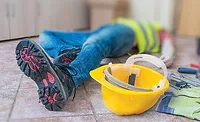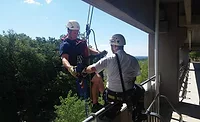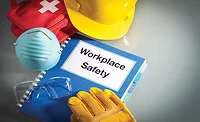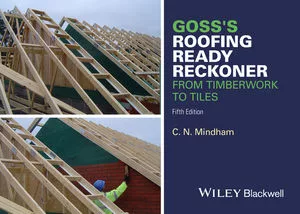Roofing Contractors Get Rescue Ready
Rooftop risk assessment is a necessary stop on every job before an accident occurs.
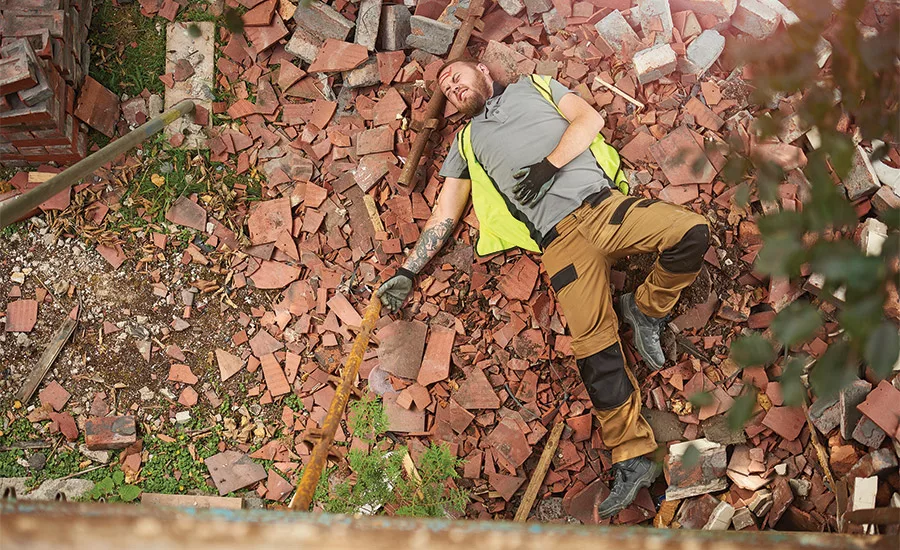
I took numerous road trips throughout the Northeast last summer, always keenly aware of roof projects along the way. My wife calls it “roof-spooking,” but I prefer wildlife observation. It’s usually from a distance with field binoculars, and to observe work in its natural habitat. Last season, I roof-spooked more than a dozen mostly residential crews working without fall protection. Discouraging as it seems, only one made the effort to work at height with a bare semblance of 50 percent tie-off. I am convinced it remains the overall nature of the construction industry to “run bare” when it comes to implementing fall protection. As good as the equipment design has become since 1998, let’s face it — wearing a harness, lanyard, lifeline and anchor point can still be cumbersome on any roof.
The Occupational and Health Administration (OSHA) begins its preamble to Pamphlet #3755-05/2015 “Protecting Roof Workers” with the three necessary steps required of roofing contractors: plan, provide and train. It also restates the obvious: “Falls are the leading cause of work-related injuries and death among roofers.”
OSHA goes on to identify the three indirect causes of most roofing deaths: Lack of any practical fall protection plan; missing or damaged fall protection equipment; improper or inadequate set-up and use (poor training).
I once offered three contractors with recent OSHA citations free 24-hour fall protection training. All three declined, responding “Perhaps some other time.” They knew the employer’s federal duty to provide fall protection and the employee’s right to fall protection over six feet would preface all training. Remember, unlike “prevention,” the term “protection” implies that the fall will potentially happen and the employer is obligated to arrest and suspend any fallen worker while mitigating their impact forces. Any reasonable person would agree without adequate training and the proper equipment that just isn’t going to happen. The result is a working population that has grown comfortable with an acceptable loss policy: “I need a volunteer to die or be seriously injured this year.”
Imagine
If, in reality, a vast majority of roofers refuse PFAS in place of the freedom to free-walk a roof, what can anyone do? What can OSHA actually do? Nationwide they have approximately 1,200 compliance officers to inspect 130 million workers on 8 million work sites.
While OSHA’s budget increased, the percentage of dollars available for site inspections was reduced. With those odds, it is more like you’ll win the lottery twice before your roofing job is inspected. Realistically, depending on the size of your company, “Plan-Provide-Train” could cost the roofing contractor thousands, or tens of thousands of dollars, each and every year.
Logging thousands of man hours on the roof without a fall (how many near-misses?) should never constitute encouragement to continue free-walking, but rather a warning of what’s to come. And why bid for an overhead expense like fall protection, in preparation for an improbable fall, when your competitors obviously do not? These two factors alone go a long way to explain the lack of PFAS in residential and commercial roofing. However, the acts and conditions directly contributing to roof falls are exactly the same on a roof utilizing PFAS as one that does not. So, what if an employer wanted to position him/herself in that “Hey, I tried” zone, between total compliance and total neglect? What would that look like?
What could happen?
When you read the details from just a hundred of thousands of OSHA inspection reports on fatal falls, you realize there are almost as many ways to initiate the fall as there are roofers on your crew: Snow and ice, high winds, poor visibility, roof debris, electrical shock, falling object, falling worker, hypo or hyperthermia, heart attack and stroke, drugs and alcohol just to name a few. The instant your center of gravity moves outside your base, gravity takes over. Whether or not the fall results in a slow backslide down a 6:12 or rapid tumble off of a 12:12, time and distance determine the results.
As young roofers back in the ‘60s, we would spend a few minutes during lunch sharpening the straight claws of our hammers with a mill file and practice quick draws. I used the piton trick more than once. Today, a nail gun would be of little help in a fall, unless the hose hung up and you happened to hang on. So, what would be the one item I could suggest to that contractor who elects NOT to protect his roofers from falls?
Once a falling worker without PFAS passes either the eave or rake edge, all one can hope for is a short fall into dense shrubbery. Landscape plantings are not much of a fall protection plan. Other than that rare occurrence, the results are discouraging. But what if the fall-in-place worker had a critical injury or suffered the onset of cardiac infarction or heat prostration. Without established PFAS, how can the employer protect him or her until emergency medical help arrives? I have developed a first responder kit for free-walkers packed into an inexpensive bicycle pannier saddle bag that can straddle the ridge in preparedness. One side of the saddlebag contains double Ziploc-type bags with the primary contents of a first-aid kit, including: bottled water, aspirin or n-saids, insta-freeze ice packs, mylar blanket (for shock), antiseptics and bleeding control supplies, and, of course, a back-up cell phone with a charged battery. The opposite saddlebag should contain the minimum amount of equipment required to secure the injured (or unconscious) victim to the roof in order to prevent further injuries or falls during treatment. This bag includes: a body belt for the victim (3,000 pound-rated fall restraint device only), an adjustable 25-foot lifeline with safety clips on each end, a temporary ridge anchor with fasteners. Doubling up the quantity could also provide the first-aid provider equal static fall protection until the professionals arrive.
I realize this whole concept is totally reactive rather than proactive and some would say a farce, but when I face the truth about many roofers, semi-preparedness looks a lot better than doing nothing during an emergency. To watch helplessly as an injured coworker (without fall protection) struggles on the deck with pain, shock or loss of consciousness before falling off is certainly a chilling thought. Chances are, if employers actually choose to prepare this roof rescue kit, then they would already have their crews trained and equipped in PFAS and this kit would represent a back-up plan. At the very least, with this kit and some tail-gate training, the crew will have the opportunity to secure, defend and provide minimum first aid to their co-worker for those minutes (or hours) before rescue EMT arrives and make accesses. Furthermore, the 30 liter double panier bag hung across the ridge can handily accommodate a few other site-specific items (i.e., frozen water bottles, Mylar blanket, instant ice, splint, duct tape, etc.) as needed.
It’s been my experience that if you come across a roofing crew working without fall protection, it’s likely nothing you say will cause them to alter behaviors. Even polite, constructive criticism will be either ignored at best, or assaulted at worst. Without bothering to take the time to perform a rooftop risk assessment, the employer’s typical response is “We’ve been roofing this way for years and NEVER had any accidents.” We all know that level of complacency helps fill graveyards.
Looking for a reprint of this article?
From high-res PDFs to custom plaques, order your copy today!



